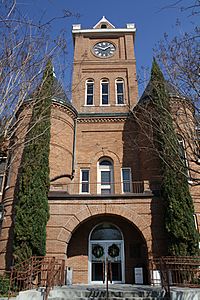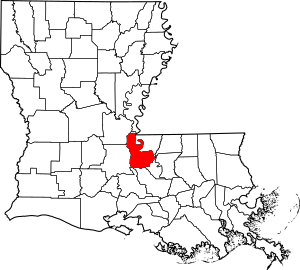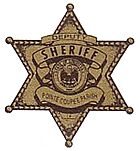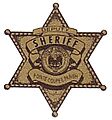Pointe Coupee Parish, Louisiana facts for kids
Quick facts for kids
Pointe Coupee Parish
|
|
|---|---|

Pointe Coupee Parish Courthouse
|
|

Location within the U.S. state of Louisiana
|
|
 Louisiana's location within the U.S. |
|
| Country | |
| State | |
| Founded | 1807 |
| Named for | French for the place of the cut-off |
| Seat | New Roads |
| Largest city | New Roads |
| Area | |
| • Total | 591 sq mi (1,530 km2) |
| • Land | 557 sq mi (1,440 km2) |
| • Water | 33 sq mi (90 km2) 5.6% |
| Population
(2020)
|
|
| • Total | 20,758 |
| • Estimate
(2021)
|
20,356 |
| • Density | 35.124/sq mi (13.561/km2) |
| Demonym(s) | Pointe Coupean |
| Time zone | UTC−6 (Central) |
| • Summer (DST) | UTC−5 (CDT) |
| ZIP Codes |
70715, 70729, 70732, 70736, 70747, 70749, 70752, 70753, 70755, 70756, 70759, 70760, 70762, 70773, 70783
|
| Area code | 225 |
| Congressional district | 6th |
Pointe Coupee Parish (say it like poynt kuh-PEE or pwahnt koo-PAY) is a special type of county called a parish in the state of Louisiana. In 2020, about 20,758 people lived here. The main town and government center is New Roads.
Pointe Coupee Parish is part of the larger Baton Rouge area. This means it's connected to a big city for jobs and services. In 2010, the very center of Louisiana's population was found right here in New Roads!
Contents
History of Pointe Coupee Parish
Pointe Coupee is one of the Mississippi River's oldest settlements. It was started by Canadian trappers around 1708. A military fort was built here even before the city of New Orleans began. The fort moved in 1722 to a spot near the current St. Francisville Ferry.
After some big floods, Governor Luis de Unzaga moved the main European settlement in 1772. This new place was called Post Unzaga. It even had its own church. Later, after a slave uprising in 1795, this settlement was left empty.
Pointe Coupee Parish was officially set up by European Americans in 1805. At first, it was called Pointe Coupee County. It was one of the first 12 counties in the Territory of Orleans. Louisiana became a state in 1812. In 1816, it was renamed Pointe Coupee Parish. The parish's borders changed a few times until 1852.
In 2008, Hurricane Gustav caused a lot of damage in Pointe Coupee.
Geography and Nature
Pointe Coupee Parish covers about 591 square miles. Most of this area, 557 square miles, is land. The other 33 square miles (about 5.6%) is water. The land here has many open fields (prairies) and swampy areas.
Main Roads in Pointe Coupee
The parish has almost 500 miles of highways. These roads help people travel and connect communities.
 U.S. Highway 190
U.S. Highway 190 Louisiana Highway 1
Louisiana Highway 1 Louisiana Highway 10
Louisiana Highway 10 Louisiana Highway 15
Louisiana Highway 15 Louisiana Highway 77
Louisiana Highway 77 Louisiana Highway 78
Louisiana Highway 78 Louisiana Highway 81
Louisiana Highway 81 Louisiana Highway 411
Louisiana Highway 411 Louisiana Highway 413
Louisiana Highway 413 Louisiana Highway 414
Louisiana Highway 414 Louisiana Highway 415
Louisiana Highway 415 Louisiana Highway 416
Louisiana Highway 416 Louisiana Highway 417
Louisiana Highway 417 Louisiana Highway 418
Louisiana Highway 418 Louisiana Highway 419
Louisiana Highway 419 Louisiana Highway 420
Louisiana Highway 420
Rivers and Lakes
Pointe Coupee Parish has several important waterways:
- Atchafalaya River
- False River
- Mississippi River
- Old River
- Raccourci Old River (this is actually a curved lake, not a river)
- Red River
Neighboring Parishes
Pointe Coupee Parish shares its borders with seven other parishes:
- Concordia Parish (north)
- West Feliciana Parish (northeast)
- West Baton Rouge Parish (east)
- Iberville Parish (south)
- St. Martin Parish (southwest)
- St. Landry Parish (west)
- Avoyelles Parish (northwest)
Protected Natural Areas
Part of the Atchafalaya National Wildlife Refuge is located in Pointe Coupee Parish. This refuge helps protect wildlife and their natural homes.
Towns and Communities
Pointe Coupee Parish has several towns and smaller communities where people live.
Cities and Towns
Villages
Census-Designated Place
Smaller Communities
There are many smaller, unincorporated communities throughout the parish. Some of these include:
People of Pointe Coupee Parish
| Historical population | ||
|---|---|---|
| Year | Pop. | ±% |
| 1745 | 600 | — |
| 1810 | 3,187 | +431.2% |
| 1820 | 4,912 | +54.1% |
| 1830 | 5,942 | +21.0% |
| 1840 | 7,898 | +32.9% |
| 1850 | 11,339 | +43.6% |
| 1860 | 17,718 | +56.3% |
| 1870 | 12,981 | −26.7% |
| 1880 | 17,785 | +37.0% |
| 1890 | 19,613 | +10.3% |
| 1900 | 25,777 | +31.4% |
| 1910 | 25,289 | −1.9% |
| 1920 | 24,697 | −2.3% |
| 1930 | 21,007 | −14.9% |
| 1940 | 24,004 | +14.3% |
| 1950 | 21,841 | −9.0% |
| 1960 | 22,488 | +3.0% |
| 1970 | 22,002 | −2.2% |
| 1980 | 24,045 | +9.3% |
| 1990 | 22,540 | −6.3% |
| 2000 | 22,763 | +1.0% |
| 2010 | 22,802 | +0.2% |
| 2020 | 20,758 | −9.0% |
| 2022 (est.) | 20,151 | −2.9% |
| U.S. Decennial Census 1790-1960 1900-1990 1990-2000 2010 |
||
In 2020, the parish had 20,758 residents. Most people identified as White (about 59%) or Black/African American (about 35%). A smaller number of people were Native American, Asian, Pacific Islander, or from other backgrounds. About 3% of the population was Hispanic or Latino.
In 2000, most people (93.61%) spoke only English at home. However, a good number of people also spoke French or Cajun French (4.89%). Some also spoke Spanish or Louisiana Creole French.
The main religion in the parish is Christianity. The Catholic Church is the largest group, followed by Southern Baptists.
Economy and Jobs
Pointe Coupee Parish has a few big employers. Nan Ya Plastics Corporation America has a large factory near Batchelor. NRG / Big Cajun 1 & 2 power plants near New Roads also provide many jobs.
The parish's economy relies a lot on agriculture. Sugar cane is one of the most important crops grown here.
Education for Students
The Pointe Coupee Parish School Board manages the public schools.
Public Schools
- Livonia High School (for grades 7-12)
- Stem Magnet Academy
- Valverda Elementary
- Rougon Elementary
- Rosenwald Elementary
- Upper Pointe Coupee Elementary
Private Schools
- Catholic Elementary of Pointe Coupee / Catholic High School of Pointe Coupee
- False River Academy
Higher Education
Students can also attend colleges in the area.
- South Louisiana Community College has services for the parish.
- Baton Rouge Community College has a campus in New Roads. It offers many technical and academic courses.
Law Enforcement
| Pointe Coupee Parish Sheriff's Office | |
|---|---|
 |
|
 |
|
| Abbreviation | PCSO |
| Agency overview | |
| Formed | 1807 |
| Jurisdictional structure | |
| General nature | |
| Operational structure | |
| Headquarters | New Roads, Louisiana |
| Deputy Sheriffs | 125 |
| Agency executive |
|
| Facilities | |
| Stations | 3 |
The Pointe Coupee Sheriff's Office is in charge of keeping the peace in the parish. They have deputies who patrol the roads. They also have special teams like a water patrol, a horse patrol, and an aviation (air) unit. They also run the parish prison and investigate crimes. The main office is in the courthouse in New Roads. Over 100 full-time deputies work for the department.
Famous People from Pointe Coupee Parish
Many notable people have connections to Pointe Coupee Parish:
- Lindy Boggs (1916-2013) – She was a U.S. Representative and later an Ambassador.
- Brian J. Costello – A writer who lives in New Roads.
- Emmitt Douglas (1926–1981) – He led the Louisiana NAACP for many years.
- Ernest Gaines – A well-known author.
- Buddy Guy – A famous blues guitarist and singer.
- Russel L. Honoré – A retired Lieutenant General from the U.S. Army.
- J. Thomas Jewell – A state representative and Speaker of the Louisiana House.
- Catherine D. Kimball – A former Chief Justice of the Louisiana Supreme Court.
- Major General John Archer Lejeune – A career military officer and leader of the US Marine Corps.
- deLesseps Story Morrison (1912–1964) – Born in New Roads, he was elected mayor of New Orleans four times.
- Julien Poydras – An early U.S. Representative for Louisiana and a generous helper of the community.
- Patrick Queen – A football player for the Baltimore Ravens.
- James Ryder Randall – A poet who wrote "Maryland, My Maryland", the state song of Maryland, while living here.
Images for kids
See also
 In Spanish: Parroquia de Pointe Coupee para niños
In Spanish: Parroquia de Pointe Coupee para niños



